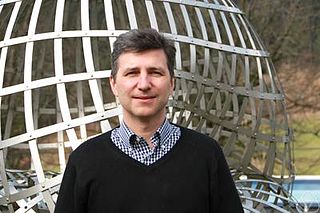A Doctor of Science is a science doctorate awarded in a number of countries throughout the world. In some countries, a Doctor of Science is the degree used for the standard doctorate in the sciences; elsewhere a Doctor of Science is a "higher doctorate" awarded in recognition of a substantial and sustained contribution to scientific knowledge beyond that required for a Doctor of Philosophy (PhD).

TU Wien, also known as the Vienna University of Technology, is a public research university in Vienna, Austria.

Geoinformatics is a scientific field primarily within the domains of Computer Science and technical geography. It focuses on the programming of applications, spatial data structures, and the analysis of objects and space-time phenomena related to the surface and underneath of Earth and other celestial bodies. The field develops software and web services to model and analyse spatial data, serving the needs of geosciences and related scientific and engineering disciplines. The term is often used interchangeably with Geomatics, although the two have distinct focuses; Geomatics emphasizes acquiring spatial knowledge and leveraging information systems, not their development. At least one publication has claimed the discipline is pure computer science outside the realm of geography.
Geographic information science or geoinformation science is a scientific discipline at the crossroads of computational science, social science, and natural science that studies geographic information, including how it represents phenomena in the real world, how it represents the way humans understand the world, and how it can be captured, organized, and analyzed. It is a sub-field of geography, specifically part of technical geography. It has applications to both physical geography and human geography, although its techniques can be applied to many other fields of study as well as many different industries.

Robert David Stevens is a professor of bio-health informatics. and former Head of Department of Computer Science at The University of Manchester
A feature, in the context of geography and geographic information science, is something that exists at a moderate to global scale at a location in the space and scale of relevance to geography; that is, at or near the surface of Earth. It is an item of geographic information, and may be represented in maps, geographic information systems, remote sensing imagery, statistics, and other forms of geographic discourse. Such representations of features consist of descriptions of their inherent nature, their spatial form and location, and their characteristics or properties.

Gerhard Chroust is an Austrian systems scientist, and Professor Emeritus for Systems Engineering and Automation at the Institute of System Sciences at the Johannes Kepler University Linz, Austria. Chroust is an authority in the fields of formal programming languages and interdisciplinary information management.
Vlatko Vedral is a Serbian-born physicist and Professor in the Department of Physics at the University of Oxford and a Fellow of Wolfson College, Oxford. Until the summer of 2022 he also held a joint appointment at the Centre for Quantum Technologies (CQT) at the National University of Singapore. He is known for his research on the theory of quantum entanglement and quantum information theory. He has published numerous research papers, which are regularly cited, in quantum mechanics and quantum information, and was awarded the Royal Society Wolfson Research Merit Award in 2007. He has held a lectureship and readership at Imperial College, a professorship at Leeds and visiting professorships in Vienna, Singapore (NUS) and at the Perimeter Institute for Theoretical Physics in Canada. He is the author of several books, including Decoding Reality.
The National Center for Geographic Information and Analysis (NCGIA) was founded in 1988 and hosted at three member campuses: The University of California, Santa Barbara; the State University of New York at Buffalo; and the University of Maine.
Werner Kuhn is a professor of Geographic Information Science at University of California, Santa Barbara. He served as the Director of the UCSB Center for Spatial Studies, and is one of the founding members of the Vespucci Initiative for Advancing Geographic Information Science, organizing annual summer schools and specialist meetings.
The Centre for Advanced Spatial Analysis (CASA) is a research centre at University College London (UCL), which specialises in the application and visualisation of spatial analytic techniques and simulation models to cities and regions. It is a constituent department of The Bartlett Faculty of the Built-Environment.

Rein Ahas was an Estonian geographer and a professor at the University of Tartu.

Cognitive geography is an interdisciplinary study of cognitive science and geography. It aims to understand how humans view space, place, and environment. It involves formalizing factors that influence our spatial cognition to create a more effective representation of space. These improved models assist in a variety of issues, for example, developing maps that communicate better, providing navigation instructions that are easier to follow, utilizing space more practically, accounting for the cultural differences on spatial thinking for more effective cross-cultural information exchange, and an overall increased understanding of our environment.
Daniel R. Montello is an American geographer and professor at the Department of Geography of the University of California Santa Barbara, and at its Department of Psychological & Brain Sciences, known for his work on geovisualization and cognitive geography.
Sandra Lach Arlinghaus is an American educator who is adjunct professor in the School of Natural Resources and Environment at the University of Michigan. Her research concerns mathematical geography.
Aleš Leonardis is professor of computer and information science at the University of Birmingham and at the University of Ljubljana. He is also an adjunct professor at the Faculty of Computer Science of the Graz University of Technology and a former visiting researcher of the Laboratory at the University of Pennsylvania, postdoc of TU Wien and visiting professor at ETH Zurich.
Reinhard Moratz is a German science educator, academic and researcher. He is Ausserplanmässiger Professor at the University of Münster’s Institute for Geoinformatics. He has worked on spatial cognition and reasoning, qualitative theories of low-dimensional entities like straight line segments and oriented points, artificial intelligence and specifically the OPRA calculus. His research is based on computational models that account for the varying reference frames used in giving verbal instructions about navigation.

Michael Drmota is an Austrian mathematician and professor at TU Wien.
Silvia Miksch is an Austrian computer scientist working in information visualization, particularly for time-oriented and medical data. She is head of the Centre for Visual Analytics Science and Technology at TU Wien.
Michael P. Peterson is an American geographer and cartographer whose research is in the fields of Geographic information systems and computer cartography, particularly as they relate to the Internet and World Wide Web. He has been a professor at the University of Nebraska Omaha since 1982. He was the president of the North American Cartographic Information Society between 1996 and 1997 and editor of the journal Cartographic Perspectives from 1998 to 2001.






